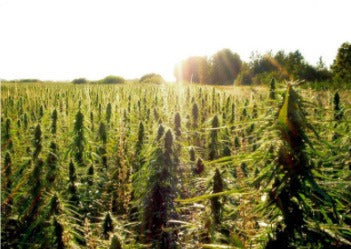
To get the most out of your marijuana, understanding the factors that influence potency is crucial. One question that often arises is whether weed loses THC as it dries out. After harvest, cannabis naturally undergoes a drying process that plays a vital role in its maturation and the development of its unique cannabinoids and terpenes. However, this same process can eventually lead to a decline in THC levels, potentially affecting the user experience. So, does weed lose THC when it dries out, and how long does it take THC to degrade? Let’s take a closer look!
Why Does Marijuana Undergo a Drying Process?
The process of drying marijuana is a crucial step in the journey from farm to pipe, as it not only affects the quality and potency of the final product but also plays a significant role in THC development and bud quality.
After cannabis plants have been harvested, their moisture content is still relatively high. This excessive moisture can make it more challenging for marijuana users to light the flowers for smoking. It also leaves the plants prone to mold and bacteria growth.
Drying marijuana solves this problem by carefully controlling environmental factors such as temperature, humidity, and airflow to remove excess moisture from the plant material. This process typically takes between 7 to 14 days, depending on the specific conditions.
What Are the Best Conditions for Drying Weed?
During the drying and curing period, the harvested buds are often hung upside down in a dark, well-ventilated space with a consistent temperature of around 60-70°F (15-21°C) and a relative humidity of 45-55%.
These conditions help to slow down the drying process, allowing for gradual moisture evaporation. These ideal conditions also preserve the essential oils, terpenes, and cannabinoids that contribute to the plant's aroma, flavor, and potency.
Average THC Content in Freshly Harvested Marijuana
When cannabis is freshly harvested, the concentration of THC and other cannabinoids may not yet be at its peak. In fact, the levels of these compounds can vary greatly depending on the specific strain, growing conditions, and the stage of maturity at which the plant was harvested. This is because cannabinoids, including THC, develop and change throughout the plant's life cycle, with their concentrations typically increasing as the plant matures.
In the early stages of growth, the cannabis plant contains very low levels of THC. Instead, it primarily produces THCA (tetrahydrocannabinolic acid), a non-psychoactive precursor to THC.
As the plant continues to grow and is exposed to light, heat, and air, the THCA gradually undergoes decarboxylation, converting it into THC. This process is essential for unlocking the psychoactive effects of the compound. However, it is important to note that this conversion is not yet complete when the plant is freshly picked.
The development of cannabinoids is also influenced by the presence of terpenes, the aromatic compounds responsible for the distinct aromas of different cannabis strains. Terpenes and cannabinoids share a synergistic relationship, with terpenes playing a role in modulating and enhancing the overall effects of cannabinoids. As the plant matures and the terpene profile develops, the interaction between these compounds can lead to increased THC concentrations and a more potent final product.
During the drying and curing process, further decarboxylation occurs, enabling the conversion of more THCA into THC and allowing the cannabinoids to reach their optimal levels. This is why properly dried and cured cannabis typically has higher THC concentrations than freshly-picked weed.
What Are the Benefits of Drying Weed Properly?
We said that drying out weed is crucial for a pleasant user experience. Why is that? There are several benefits to properly drying marijuana.
Breaks Down Chlorophyll
Drying and curing weed helps to break down chlorophyll. Chlorophyll is a green pigment found in plants that plays a vital role in photosynthesis, the process by which plants convert sunlight into energy.
In harvested marijuana buds, excessive chlorophyll can result in harsher smoke and an unpleasant, grassy taste. Proper curing is essential to break it down and improve the overall flavor and smoothness of the cannabis.
Helps with Cannabinoid Development
During curing, the slow breakdown of chlorophyll and other plant materials occurs, allowing for the full development of the cannabis's cannabinoid and terpene profiles. This maturation process not only improves the overall quality and experience of the final product but also contributes to the potency of the plant.
How Long Should You Dry Weed Out to Get Optimal THC Content?
The optimal drying and curing time for marijuana can vary depending on factors such as the strain, environmental conditions, and personal preferences. However, a general recommendation is to cure cannabis for at least 2-4 weeks to ensure proper THC development and enhance the overall quality of the buds.
Some cannabis connoisseurs might prefer to extend the process up to 6-8 weeks or even longer, as a longer curing period can further improve the characteristics of the plant.
However, waiting too long may also lead to THC degradation. It's essential to monitor the curing environment consistently and maintain proper temperature, humidity, and airflow to achieve the best results.
What Happens if You Dry Out Marijuana for Too Long?
When marijuana dries out beyond the optimal point, some undesirable effects may occur. Overly dry buds can become brittle and crumbly, making them difficult to handle and resulting in a less enjoyable smoking or vaping experience.
Additionally, as the moisture content decreases, so too can the levels of THC and other cannabinoids. This decline in potency occurs because THC, in its natural acidic form (THCA), undergoes decarboxylation when exposed to heat, light, or air for extended periods.
While decarboxylation is necessary for activating the psychoactive effects of THC, excessive exposure can lead to the degradation of cannabinoids and a decrease in potency.
What Changes THC Levels During Drying?
There are several factors that can contribute to the degradation of THC during the drying process, with heat, light, and oxygen exposure being the most significant. Understanding the impact of these elements on THC levels is crucial for preserving the potency of cannabis during post-harvest processing.
Heat
Heat plays a critical role in the decarboxylation process, which, as we mentioned, involves the conversion of THCA into psychoactive THC. While decarboxylation is necessary for activating the psychoactive effects of THC, excessive heat can accelerate the degradation of cannabinoids, including THC, into less potent compounds such as CBN (cannabinol). To minimize the loss of THC during the drying process, it is essential to maintain a controlled temperature of around 60-70°F (15-21°C).
Ultraviolet Light
Light, particularly ultraviolet (UV) light, is another factor that can lead to the breakdown of THC. Exposure to UV light can cause the molecular structure of THC to change, resulting in the formation of less potent compounds. This is why it is recommended to dry cannabis in a dark environment, as it helps to protect the buds from light-induced degradation.
Oxygen
Oxygen exposure can also contribute to the decline of THC levels during the drying process. When THC is exposed to oxygen, it can oxidize and degrade into CBN or other less potent compounds. To reduce the risk of oxidation, it is important to store dried cannabis in an airtight container to limit its contact with air.
Time Frame
The time frame for THC degradation is another crucial factor to consider. The longer the cannabis is exposed to heat, light, and oxygen, the more THC will be lost. As mentioned earlier, the optimal drying period typically ranges from 7 to 14 days.
However, once the drying and curing processes are complete, it is essential to store the cannabis properly to minimize further degradation over time. A cool, dark, and airtight environment is ideal for preserving the THC content and overall potency of the buds.
Does Drying Methods Accelerate THC Degradation?
The drying process plays a crucial role in preserving the potency of cannabis, as different drying methods can have varying impacts on THC loss. Two common approaches to drying cannabis are air drying and accelerated drying techniques. Each method has its advantages and disadvantages in terms of THC preservation, overall quality, and the resulting user experience.
Air Drying
Air drying is the traditional and most widely used method for drying cannabis. It involves hanging the harvested plants or branches in a dark, cool, and well-ventilated space with controlled temperature and humidity levels.
This slow and gentle process usually takes 7 to 14 days and allows the plant to retain its cannabinoid profile, including THC, more effectively. As the cannabis dries gradually, the risk of over-decarboxylation and subsequent THC degradation is minimized.
Additionally, air drying helps preserve terpenes, which contribute to the aroma, flavor, and overall experience of the cannabis. However, air drying requires more time and space compared to other methods.
Accelerated Drying
Accelerated drying techniques, such as using heat or dehydrating machines, aim to speed up the drying process by exposing the cannabis to higher temperatures or forced air. While these methods can shorten the drying time significantly, they may also increase the risk of THC loss.
Higher temperatures can cause excessive decarboxylation, leading to the conversion of THC into less potent compounds like CBN. Furthermore, the rapid drying process may compromise the preservation of terpenes, resulting in a less aromatic product.
What Causes THC to Degrade After You Purchase Weed?
After purchasing cannabis, several factors can cause THC to degrade, potentially affecting its potency and overall user experience. The primary causes of THC degradation include exposure to light, heat, oxygen, and humidity.
Sunlight Exposure
Exposure to sunlight, particularly ultraviolet light, can break down THC molecules and lead to the formation of less potent compounds. To minimize light-induced degradation, store your cannabis in a dark, opaque container or a location that is not exposed to direct sunlight.
Excessive Temperatures
High temperatures can accelerate the decarboxylation process, which converts THC into other cannabinoids. While some decarboxylation is necessary for activating the psychoactive effects of THC, excessive heat can degrade THC and reduce its potency. Ideally, store your cannabis in a cool environment with temperatures between 60-70°F (15-21°C).
Air Exposure
When THC is exposed to oxygen, it can oxidize and degrade into less potent cannabinoids. To reduce the risk of oxidation, store your cannabis in an airtight container to limit its contact with air. Vacuum-sealing the container can further minimize oxygen exposure.
High Humidity
Proper humidity control is essential for preserving the quality and potency of cannabis. High humidity levels can promote mold growth, while extremely low humidity can cause the buds to dry out excessively, leading to a decline in THC levels and a less enjoyable smoking or vaping experience. Aim to maintain a relative humidity of 55-62% when storing your cannabis .If you don’t have a humidifier, you can use Boveda gel packs to control moisture in your stash.
Storing Weed in Plastic
Storing cannabis in a moist environment, such as plastic bags, can trap heat and humidity, creating an unfavorable microclimate for preservation. The increased moisture levels heighten the risk of mold growth, which can render cannabis unsafe for consumption.
Additionally, certain types of plastic can leach chemicals over time, potentially contaminating the cannabis and posing health risks when inhaled. To avoid these issues, it is advisable to store cannabis in airtight glass containers that maintain optimal humidity levels and prevent chemical contamination.
How Long Does THC Take to Degrade from Drying Out?
There isn't a specific average number for THC degradation due to the numerous factors that influence the rate at which it breaks down, such as storage conditions, strain, and original THC content.
However, a general guideline is that properly stored cannabis can maintain its potency for 6 months to over a year. In less favorable conditions, the degradation of THC can occur more rapidly, potentially leading to noticeable declines in potency within weeks to a few months. Keep in mind that these are rough estimates, and the actual rate of THC degradation can vary significantly depending on individual circumstances.
Under optimal storage conditions (cool, dark, and airtight environment with a relative humidity of 55-62%), the degradation of THC can be significantly slowed down, and the cannabis can maintain its potency for several months to over a year.
However, when cannabis is stored improperly, such as in a dry environment with excessive heat, light, and oxygen exposure, THC degradation can occur more rapidly. In these conditions, noticeable declines in THC levels and potency can happen within weeks to a few months. To preserve the potency of THC and prolong the shelf life of your cannabis, it is crucial to store it properly by minimizing exposure to these degrading factors.
Drying Out Weed and THC Content
The drying and curing process of cannabis plays a crucial role in preserving and enhancing its THC content. While it is true that improper or accelerated drying techniques can lead to THC degradation, careful and controlled drying and curing methods, such as air drying and maintaining optimal environmental conditions, can effectively minimize THC loss.
By paying attention to factors like temperature, humidity, light exposure, and storage, cannabis users can ensure their weed retains its potency and quality. In essence, the key to preserving THC levels in dried cannabis lies in striking a balance between the speed of the drying process and the preservation of the delicate compounds that contribute to its effect and aroma. Always store your cannabis in airtight containers and in cool, dry, dark places to preserve your THC content.
Hannah Smith is Joy Organics Director of Communications. She is driven by her passion for providing clear and accessible wellness and CBD education. In 2015, she received her BA in Media, Culture and the Arts from The King’s College in New York City and before Joy Organics, worked as writer and photographer in the Middle East and North Africa. Her work has been featured on Forbes, Vice, Vox, Denver Post, and the Coloradoan.








